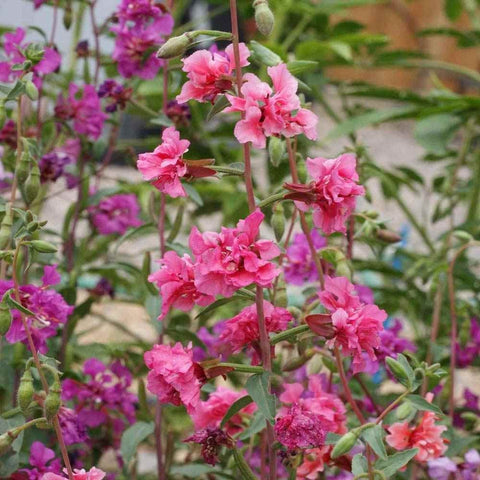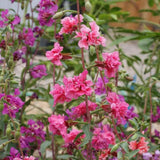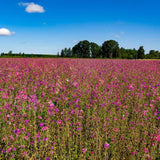Clarkias (Clarkia Unguiculata) are named after Captain William Clark of the famous Lewis and Clark expedition to the American West in 1804-1806. They grow wild on dry land and bloom during the cool season. Many cultivars have been developed, and there is much confusion in the naming of various Clarkia and closely related Godetia species. They are best sown directly outdoors in the spring and thinned to 20-30 cm between plants. Clarkias prefer sunny, but cool growing conditions and the soil should never dry out completely. They make a brilliant display massed in the border, and small roselike flowers continue opening on the long and slender racemes until autumn.
In the wild this eye-catching flower occurs only in the state of California, preferring woodland areas. Count: ~ 50 Sun Exposure Full sun from an early age Light shade when young Improved form with aquamarine flowers, long flowering season Genus Clarkia Species unguiculata Bloom Start to End Early Summer - Mid Fall Plant Height 24 in Plant Width 8 in - 10 in Additional Characteristics Flower, Butterfly Lovers, Heirloom, Hummingbird Lovers Bloom Color Pink, Purple, Red Light Requirements Full Sun Moisture Requirements Moist, well-drained Resistance Deer Resistance Soil Tolerance Normal, loamy Uses Beds, Border, Cut Flowers, Ornamental, Outdoor, WildflowersThis flower, native to California, is easy to grow and beautiful. It is scientifically named, "Clarkia", after the Lewis and Clark Expedition. The perfect flower for a cottage garden. These heirloom flowers have multiple stems with ruffled ribbonlike shapes and are easy to maintain. Deer will leave it alone while butterflies and hummingbirds flock to it.This Mountain Garland Wildflower can tolerate different weather conditions and prefers full sun but can grow in part shade. Mountain Garland is great for cut flowers, borders, or container gardens. Put these in a vase to enjoy on your table. Try adding these flowers to a bouquet, centerpiece, or dried flower arrangement.Find a sunny spot, run a garden fork through the soil to loosen it, and broadcast this seed freely. Then water, and your work is done. This flower does wonders for a pollinator garden and to add to a wildflower mix. Mountain Garland Wildflower is usually found in foothills and grassland areas.
In the wild this eye-catching flower occurs only in the state of California, preferring woodland areas. Count: ~ 50 Sun Exposure Full sun from an early age Light shade when young Improved form with aquamarine flowers, long flowering season Genus Clarkia Species unguiculata Bloom Start to End Early Summer - Mid Fall Plant Height 24 in Plant Width 8 in - 10 in Additional Characteristics Flower, Butterfly Lovers, Heirloom, Hummingbird Lovers Bloom Color Pink, Purple, Red Light Requirements Full Sun Moisture Requirements Moist, well-drained Resistance Deer Resistance Soil Tolerance Normal, loamy Uses Beds, Border, Cut Flowers, Ornamental, Outdoor, WildflowersThis flower, native to California, is easy to grow and beautiful. It is scientifically named, "Clarkia", after the Lewis and Clark Expedition. The perfect flower for a cottage garden. These heirloom flowers have multiple stems with ruffled ribbonlike shapes and are easy to maintain. Deer will leave it alone while butterflies and hummingbirds flock to it.This Mountain Garland Wildflower can tolerate different weather conditions and prefers full sun but can grow in part shade. Mountain Garland is great for cut flowers, borders, or container gardens. Put these in a vase to enjoy on your table. Try adding these flowers to a bouquet, centerpiece, or dried flower arrangement.Find a sunny spot, run a garden fork through the soil to loosen it, and broadcast this seed freely. Then water, and your work is done. This flower does wonders for a pollinator garden and to add to a wildflower mix. Mountain Garland Wildflower is usually found in foothills and grassland areas.



